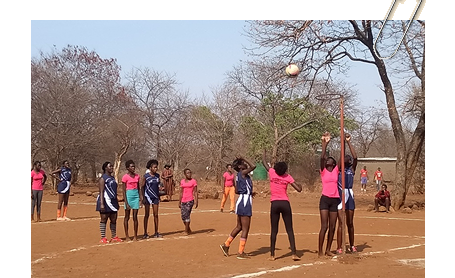The Chobe Wildlife Cup
Securing the future of conservation by building our next generation of caretakers through youth development.
Chobe East is made up of three communal conservancies – Impalila Island, Kabulabula and Kasika - which are located in the furthest eastern floodplains of the Zambezi Region in Namibia. Chobe East is the at the heart of the Kavango Zambezi Transfrontier Conservation Area’s landscape in that it is known to be the only area “where four countries meet” - Namibia, Botswana, Zambia and Zimbabwe. It is also where the Chobe and Zambezi Rivers meet; connected by the Kasaya Channel, a protected fish reserve set aside for recreational fishing.
Youth Engagement: Conservation and Tourism
The Youth Engagement Program through annual soccer tournaments was designed to create awareness, develop understanding, and change the mind-set and perception of how youth view support the event. Volleyball could be added in the future.
The program thereby evolved from a soccer tournament in 2016 to a sports tournament in 2017. In 2019, Chobe East conservancies found its name “Chobe Wildlife Cup.”
The evolution of the Chobe Wildlife Cup was possible through funding from the donors and support from the tourism industry in the Zambezi Region. The leadership and community members of Impalila, Kabulabula and Kasika Conservancies and their respective tourist operators work together to sustain the programme. Zovu Elephant Lodge contributed to the 2017 post-event clean-up of the Kasika Combined School’s sports field. Serondela Lodge of Kabulabula Conservancy provided a boat cruise as the prize to the winning team of the 2018 Netball Tournament.
The Chobe Wildlife Cup demonstrates how integrating rural development and nature conservation is possible. This is blended in the original spirit, founding and identity of IRDNC.
Youth Development: Building Our Next Generation of Conservation Caretakers
The concept will gradually move from Youth Engagement to Youth Development. Sustainable development cannot happen without human development. After 21 years of conservation management in the Zambezi region, we must now invest in our next generation of conservation caretakers. Securing the future of conservation conservation, wildlife, and conservation tourism. Members of the conservation workforce, such as game rangers and field coordinators, facilitate video shows, presentations, and open discussions prior to and during the tournament.
Evolution
So far, there have been four annual youth sports tournaments. These were hosted by Impalila Conservancy (2016, 2019), Kasika Conservancy (2017) and Kabulabula Conservancy (2018). Moral and team support from community members of the conservancies played an important role of hosts winning the tournament trophy.
The women’s netball tournament was added to the program in 2017 after a discussion among the conservancies questioned why the tournament was limited to only soccer when there was high attendance of female youth to requires commitment from stakeholders to invest in Youth Development.
Part of this concept is developing and equipping young leaders to become conservation ambassadors. One approach to achieving this is an idea that IRDNC’s Cluster Coordinator, Reuben Mafati, is exploring with Professor Ekkehard Klingelhoeffer, from the Department of Wildlife & Ecotourism at the University of Namibia’s Katima Mulilo Campus. Their goal is to re-establish Wildlife Clubs in schools. The Wildlife Clubs would serve as the platform for a series of activities and events that foster knowledge and skills in young people. For example, possible ideas include Wildlife and Environmentalism Fair scheduled around the Chobe Wildlife Cup, Wildlife Camp event and wildlife games. The Wildlife Clubs have the potential to be created at schools within the KAZA landscape.
This active learning in turn could contribute to the restructuring of the Chobe Wildlife Cup.
Vision: Chobe Wildlife Cup and KAZA
The Chobe Wildlife Cup concept was established for peace, friendship and wildlife stewardship as a means for the current generation to secure conservation for the future generations.
The Chobe Wildlife Cup is currently an event with sports teams only from the Chobe East conservancies. However, it has the potential to grow and could progress to include youth in Kasane, Botswana; Mamboba, Zambia, and Ikaba, a non-conservancy area in Namibia’s Zambezi Region. Over time, more teams from the KAZA landscape could participate, for example, Simalaha Conservancy in Zambia. The conservancies are thinking far and wide and envision increased attendance, attraction of tourists to the Namibian Wetlands Route of the Zambezi region, and community members building value supply chain micro-enterprises around the event.
The conservancies, with IRDNC’s support, aim for this to be recognized as an official sports event that is supported and opened by either a representative from the KAZA Secretariat, Zambezi Regional Council, or Ministry of Youth, Sports & National Service.
It is Reuben’s dream, and not too long from now, for this concept to be officially launched and become part of the KAZA TFCA initiatives.
“Leaders don’t create followers, they create more leaders.”
– Tom Peters
Let us create more leaders in conservation by joining hands together to ensure the sustainability of the Chobe Wildlife Cup.
About the author: Mr. Reuben Mafati has made contributions for over 20 years in the history of community-based tourism in the Zambezi region through CBNRM enterprise development. He is currently based in the Zambezi region as the Chobe East Cluster Coordinator and Regional Enterprise Development Specialist.

- Netball teams. Photo by: Reuben Mafati



